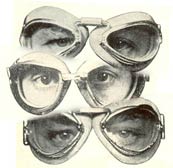Thomas Berry Colby, ca. 1928
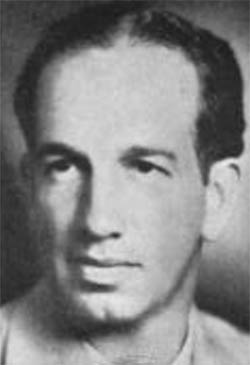 |
Thomas Berry Colby was born on May 15, 1900 in Detroit,
Wayne County, Michigan. He was one of
five children, having one sister and three brothers. Born
into privilege, he was educated at the Hill School, Pottstown,
PA, and received his B.S. at Cornell University. Image, right,
from Forden reference, left sidebar, chapter IV, page 80.
Colby landed as pilot in command five times at Tucson according to the following
table.
DATE |
AIRCRAFT |
REGISTRATION NO. |
10/30/1929 |
Ford Transport |
A-8457 |
11/12/1929 |
Great Lakes |
NC840H |
10/29/1930 |
Monocoupe |
NC533W (see ad below) |
12/26/1930 |
Monocoupe |
NC533W |
1/11/1932 |
Laird |
NC10402 |
He also landed once as a passenger with Lee Shoenhair as his pilot, see below.
At the times of his landings he was building his family
business, Berry
Brothers, which sold aircraft finishes – paints – and
other coating products. The business had been founded
by his maternal grandfather. Colby plunged into the
enterprise after his graduation from Cornell.
Although Berry Brothers sold coatings to the automobile
and marine sectors, Colby chose to focus on the aviation
business. When he visited Tucson he was Aviation Sales
Manager for the organization, having been appointed to the
position in 1927.
Though not a pilot at the time of his appointment, he talked
the company into purchasing a Waco 10 (NC6528; ATC #41; not
a Davis-Monthan airplane) and competed with it in the 1927 National Air Races (NAR) and the 1928
Ford Reliability Tour (Forden reference, left sidebar, chapter
IV). He
hired Charles W. Meyers, then chief test pilot for Advance
Aircraft Co. (makers of Waco planes) to fly the airplane. Colby
went along as passenger. They took 4th place in the National Air Tour, and first place in the NAR New York to Spokane, WA Class B race in 1928. According to a popular biography of Colby in the April 15, 1938 issue of Sportsman Pilot, he sold the Waco after the 1928 Tour and bought a Buhl.
Below, from Tim Kalina, a photograph dated September 7, 1928 of him, his airplane, and Mrs. E.A. Pendleton. The airplane is the Buhl CA-3 Airsedan biplane purchased by Colby. Note the sesquiplane design, where the lower wing is much smaller than the upper.
September 7, 1928, Before the NAR
(Source: Kalina)
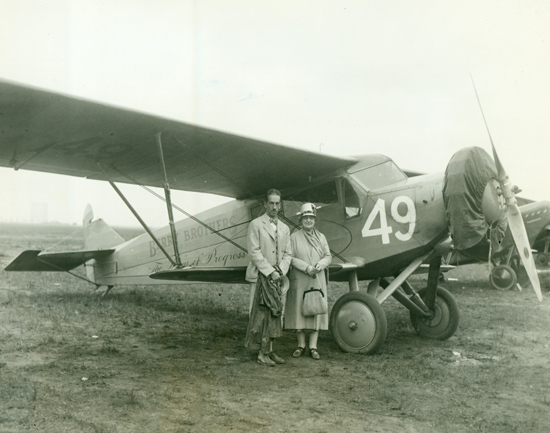 |
Regardless of the photo caption, below (he was still not a certificated pilot at this time), he flew in this Buhl in the 1928 Transcontinental Class B Race of the National Air Races (NY to Los Angeles, CA). He flew with Register pilot Lee Schoenhair, who brought the Buhl, identified as NC6816, with Colby and Mrs. Pendleton aboard. Her signature in the Register looks like "Mr." Pendelton, however. They placed 6th wearing race number 49.
September 7, 1928, Before the NAR, Caption
(Source: Kalina)
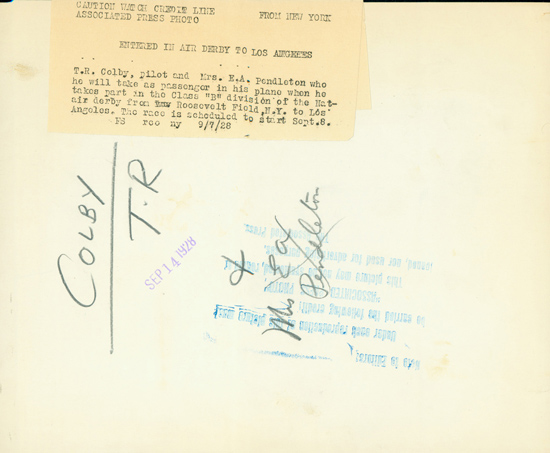 |
Finally, in 1928, he learned to fly at Culver
City, CA. He
bought the Great Lakes airplane, NC840H and had it painted
with the company name on the fuselage. He was hailed
in Detroit as the first sales manager to employ an airplane
to cover his territory (but see “Pop” Cleveland and the information about the Parker Pen Company at NC126M).
He flew the Great Lakes on his first
cross-country solo in 1929. It is during this trip
we find him at Tucson on November 12, 1929. He wrecked
the Great Lakes and bought the Monocoupe NC533W which he then
flew to Tucson twice in 1930. Then he bought the Laird.
Colby flew in the 1931 (final) Ford Air Tour. He
did not compete. Rather, he accompanied other Tour
aircraft as the "Berryloid Official Tour Airplane", clearly
an advertising and marketing opportunity. He
carried as passenger Tour Manager Ray Collins. He
flew the Laird NC10402, below. Image from Forden (left
sidebar) chapter VII, page 140.
Laird NC10402, ca. 1931
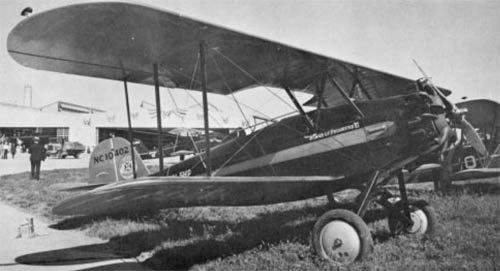 |
Tom Colby was active in flying events throughout the U.S.
and especially the Midwest. He was a founder and officer
of the Aeronautical Activities Association of Michigan. He
was also pegged by the society pages as one of Detroit’s
most eligible bachelors. However, while participating
in the Florida Air Cruise in 1933 he met one Juliette Brown
of Philadelphia during the stop in Miami. Two years
later they were married.
The Berry Brothers’ coating systems were sold under
the brand name “Berryloid” and were widely advertised
and used in the aircraft industry of the time. Many
Davis-Monthan Register aircraft were painted with Berryloid,
including NC14415 and, it is safe to assume, all of Colby’s
airplanes. Below, again from Tim Kalina, is an array of original Berryloid products. Mr. Kalina says about these products, "The can is a quart, to give a size reference. I'd imagine the dope can is from the late 1920s, and the little model aircraft dope bottles from the early 1930s. The can is still full, although I haven't open it. Two of the little bottles still contain some dope, the Loening Yellow and the Curtiss Blue, but it's dry and in a clump." The 'Aluminum' pigmented dope was used as a protective coating that prevented UV sun damage to cotton aircraft fabric. It generally went on as a first coat, followed by coats of colored dope. All these products were highly flammable.
Berryloid Coating Products, Ca. 1920s-30s (Source: Kalina)
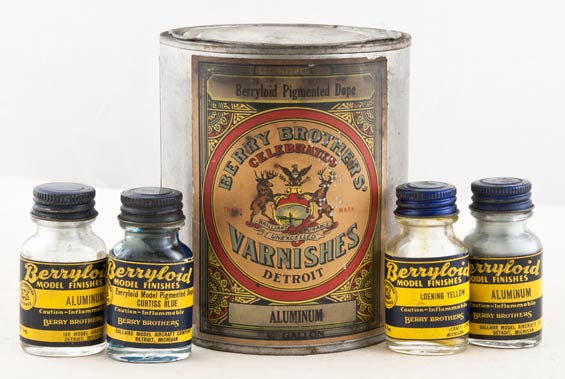 |
Image, below, of the Berryloid line from a 1931 Nicholas-Beazley
products catalog. The full catalog is avialable as a PDF
download here.
Refer to pages 27-28 for for more readable examples of aircraft
coatings of the era. Note especially the handsome Berry Brothers
Art Deco herald.
Berryloid Product Line, 1931
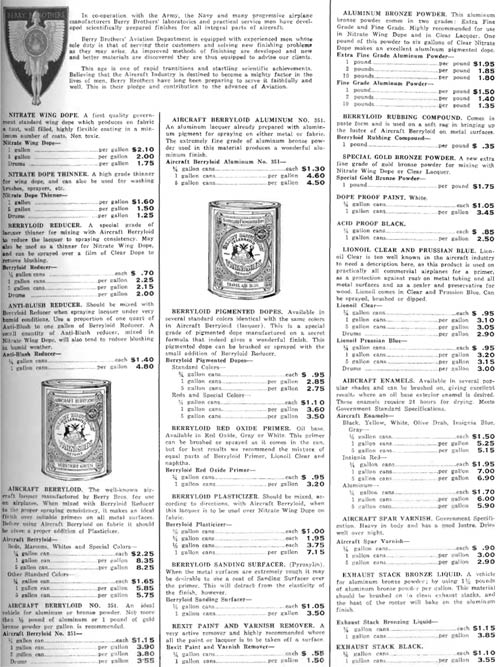 |
Coating technologies have changed immensely (and for the
better) over the years. Now, catalyzed epoxy and polyurethane
finishes are available, which are far superior in appearance
and durability (not to mention flammability qualities) to
the nitrate dopes and lacquers of the Golden Age. Prices
have changed, too. Whereas you could purchase a gallon
of pigmented Berryloid for $8.35 in 1931, as of the revision dates of this Web page, a gallon
of catalyzed epoxy paint can cost over $100. Nitrate dopes
have fared better, being in the range of 2-3 times more expensive
today.
Further from dmairfield.org friend Tim Kalina come the
following four images. The first is of the Berryloid
pigmented dope color chart. This chart is circa 1940.
Berryloid Color Chart, ca. 1940
(Source: Kalina)
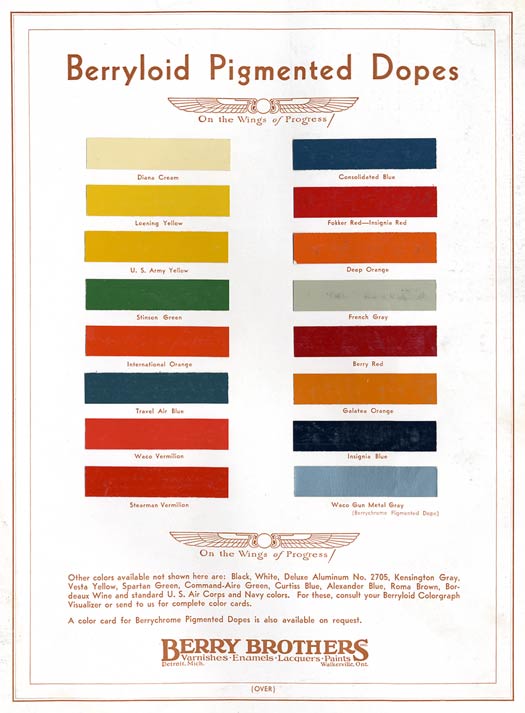 |
Older charts tend to contain more colors. The Berryloid chart below is from the early 1930s.
Berryloid Color Chart, ca. 1930
(Source: Kalina)
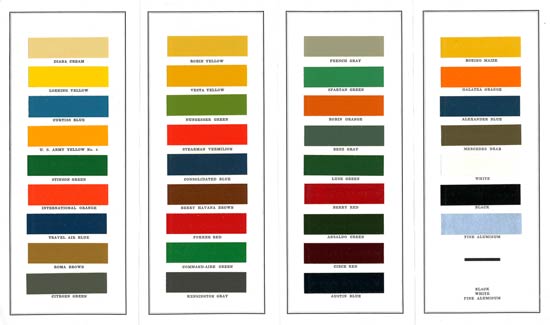 |
Given the charts above, and further to pigmented finishes in general, an article in the January 2008 issue of Skyways (cited in left sidebar) describes the line of Berryloid pigments, as well as a history of aircraft paints that includes reproductions of full-color charts for several manufacturers. Especially useful is author Eney's suggested procedures for determining the color schemes for old airplanes that may interest restorers or modelers.
This article is available for historical and educational purposes as a PDF download (1.1MB) here. The article contains black and white images of Lockheeds NC105N and NC869E. NC105N is rendered in color on the cover. A word of caution to modelers, restorers and all site visitors who may be looking for authentic color information: The color rendering of my scanner, combined with the color rendering of your monitor/printer, may not provide authentic colors for you to work from.
Below, an image of a promotional ink blotter that pictures
the "Berryloid Waco" GXE 1103 (not a Davis-Monthan Register
airplane). Named "On the Wings of Progress", this Waco won
the NY to Spokane, WA Class B National Air Derby in 1927.
The colors appear to be 'Diana Cream' on the wings, 'Renault
Red' on the upper fuselage and 'Berry Red' on the fueslage
sides and tailsurfaces. Thanks again to Tim.
"Berryloid Waco" GXE 1103
(Source: Kalina)
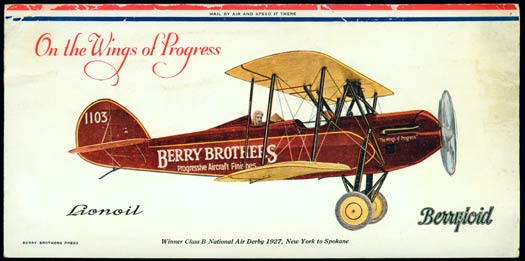 |
An interesting and compelling artifact from the Golden Age is found on the business side of the blotter above. I scanned it and exhibit it below. It appears to have been used once to blot the signature of one "Arthur Muehlbeck". You can see the results clearly. I increased the contrast and flipped the image horizontally so you can read the signature. According to the 1930 U.S. Census, Muehlbeck, age 21, lived in Detroit with his wife, Hazel (21) and their 9-month old daughter Wandajean. He was a wholesale hardware salesman.
Blotter Reversed, Showing Signature
of Arthur Muehlbeck
(Source: Kalina)
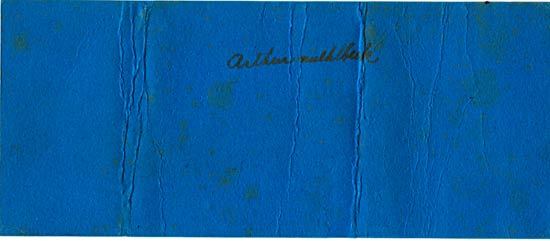 |
For other print advertising, Berryloid produced a series of full-page spreads in
the early 1930s that featured paintings of various aircraft
types done up in bird paint schemes. These ads were also
sold as a collection of prints. The mage, below, from Mr. Kalina,
depicts the Boeing representative of the series (number 7).
Compare the color chart, above. Number 4 of the series (a Travel Air monoplane in International Orange, Travel Air Blue and Vesta Yellow, suggesting a macaw) is reproduced on the back cover of the Skyways article cited above.
Boeing 80
(Source: Kalina)
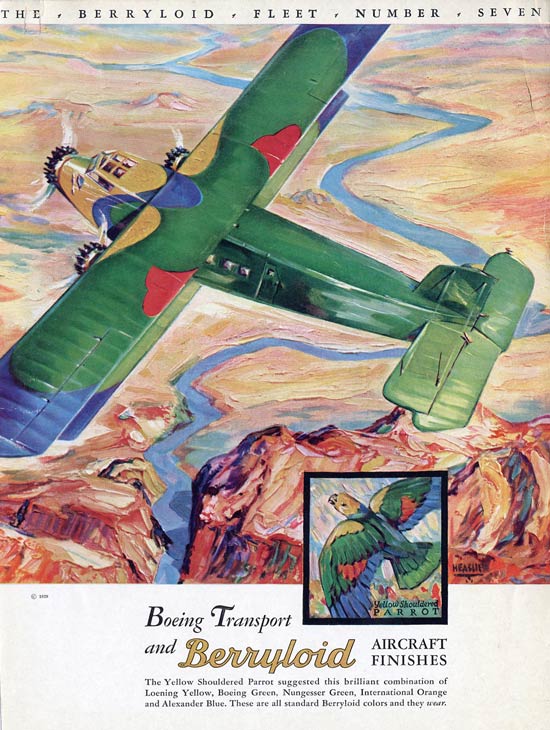 |
Pilot Colby
died in November, 1974 at Pauma Valley, San Diego County,
California. The following quotes from contemporary news articles cite the circumstances surrounding his passing. First, from the Oakland Tribune, Tuesday, November 12, 1974. Articles courtesy of site visitor Bob Woodling.
Wealthy Couple's Murder-Suicide
PAUMA VALLEY (AP) - The gunshot deaths of a wealthy resort rancher and his wife were described by the coroner's office yesterday as murder-suicide. A neighbor found the bodies of Thomas D. Colby, 74, and his wife, Midge, 60. The shooting took place Saturday or early Sunday in the Colbys home on the Lazy H Ranch northeast of Escondido which Colby founded after World War II, converting it into a resort complex with a landing strip and golf course. Deputy Coroner Warren Chambers said a note found in the house indicated the Colbys may have "intended to take their lives."
|
And from the Mexico Ledger, Friday, November 15, 1974, Mexico, Missouri
Graveside Rites Sunday For Mrs. Colby
STURGEON-Graveside services for Mrs. Thomas Colby will be held at 1 p.m. Sunday at the Mt. Horeb Cemetery, Sturgeon, by the Rev. James Jones of the First Christian Church of Sturgeon. Mrs. Colby, 61, died Nov. 10 at Pauma Valley, Calif., the same day as her husband, for whom interment was in California. She was born Dec, 17, 1913, at Floris, Ia., daughter of the late John and Lala Conner Daughtery. She was married in California and was a former resident of Columbia. Survivors of Mrs. Colby are one sister, Mrs. James (Ila Mae) Dent of Sturgeon; one brother, Rex Daughtery of Ottumwa, Iowa. She was preceded in death by one daughter. Visitation for Mrs. Colby will be at the Fenton Funeral Home at Sturgeon after 11 a.m. Saturday.
|
The Lazy H Ranch is still in existence but operates as a motel/restaurant.
---o0o---
Image, below, from current owner of Monocoupe NC533W, Norman
Cowell. Thanks to him for sharing his images here and on
the web page for NC533W.
Monocoupe NC533W Advertisement, 1930
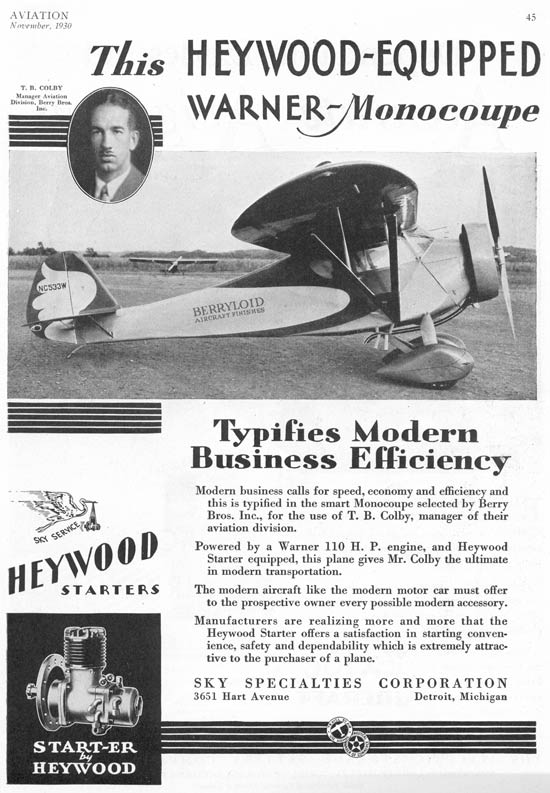 |
NC533W was delivered new with the Heywood starter. This
model was activated by compressed air. Notice also
the extension to the entry step just under the door. Colby
ordered the extension for his wife.
---o0o---
Part of Colby's job with Berry Brothers was to build the business. One way he did that was making sure the major aircraft manufacturers knew about the coating products and services. Below, is an invitation from Colby to Harold Pitcairn (not a Register pilot), founder and operator of Pitcairn Field and of a well-known line of specialized Golden Age aircraft. The first image is of a letter from Colby to Pitcairn, below, inviting him to take advantage of the facilities of a new aviation club, the Chateau Voyageurs, located near Detroit. This, and the following images, are shared by Tim Kalina.
March 12, 1929 Invitation to Harold Pitcairn (Source: Kalina)
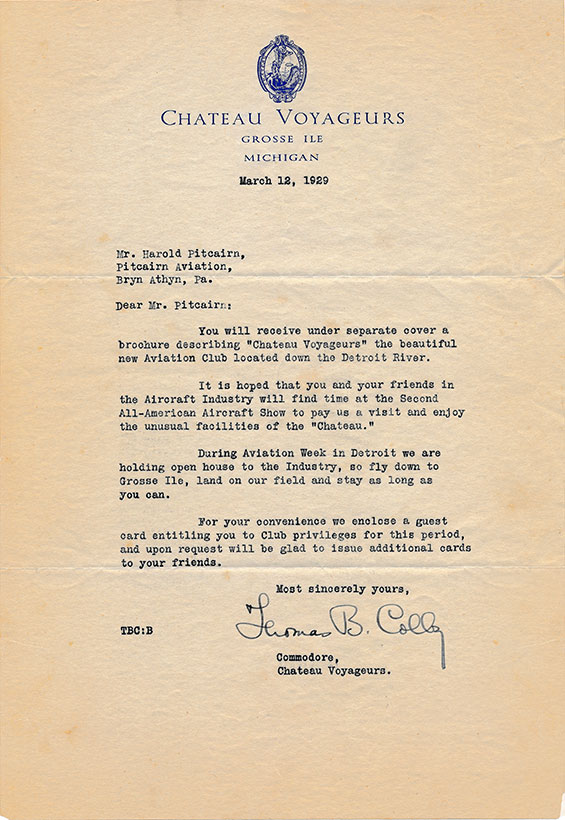 |
The generous invitation, made to coincide with Aviation Week in Detroit, showing dates, is below.
Colby-Pitcairn Invitation, 1929 (Source: Kalina)
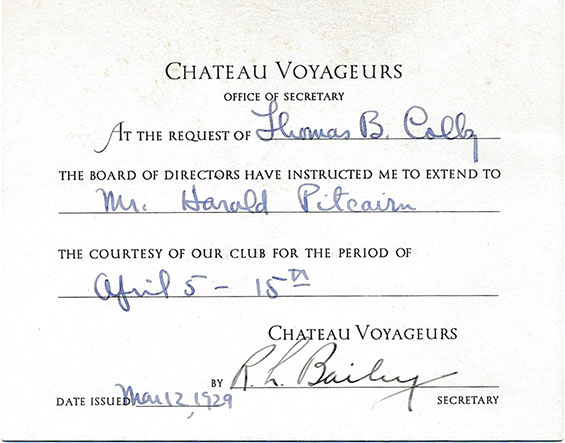 |
A courtesy map was enclosed, below.
Chateau Voyageurs Map, Detroit, MI (Source: Kalina)
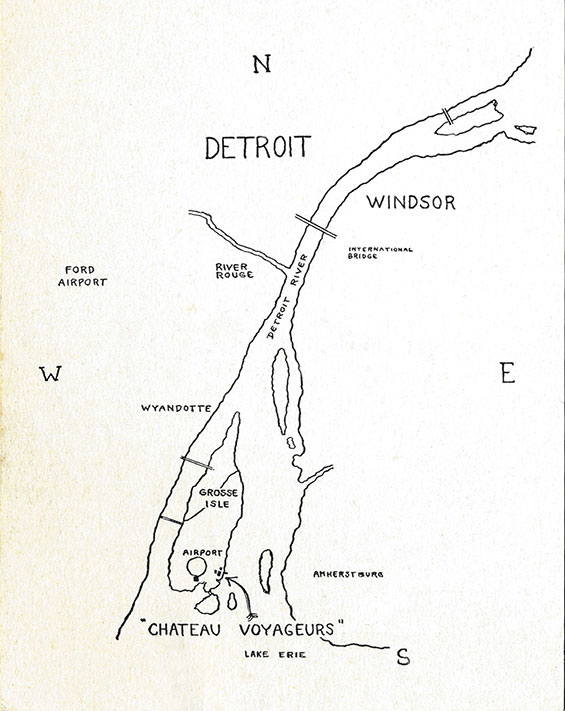 |
A Google Maps image from 2004 shows approximately the same geography. The airfield is still there.
2004 Google Map of the Same Area (Source: Google Maps)
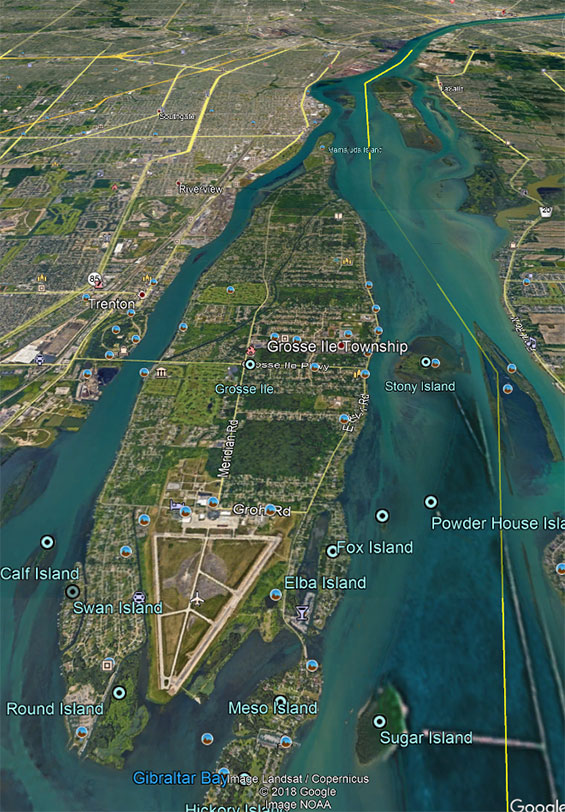 |
From August 17, 1929, the article below form Air Transportation authored by Colby describes the club facilities. Colby wrote it about six-months after his letter to Pitcairn. Notice the photograph showing the 1929 circular shape of the airfield. Compare with the map sketch above.
Air Transportation August 17, 1929 (Source: Google Books)
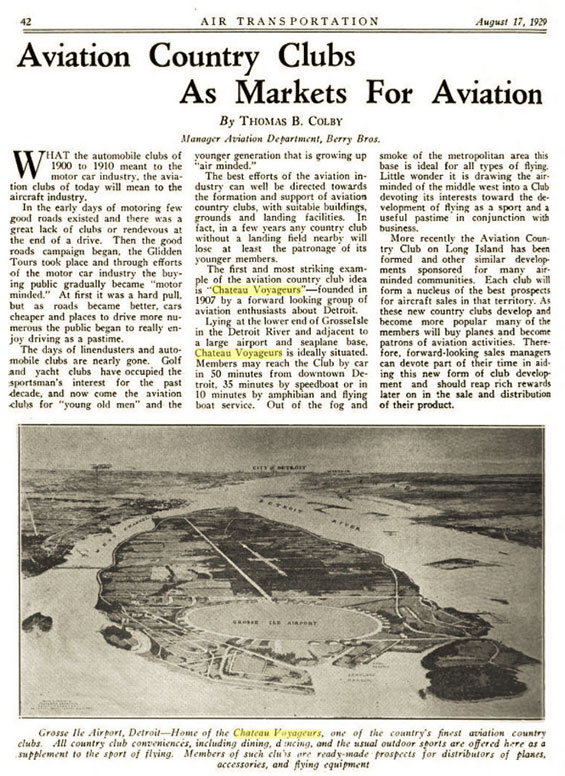 |
---o0o---
Dossier 2.1.113
UPLOADED: 06/07/07 REVISED: 06/11/07, 06/25/07, 02/23/08, 10/19/08, 07/02/09, 02/02/12, 02/05/12, 07/26/18, 08/10/11
|

